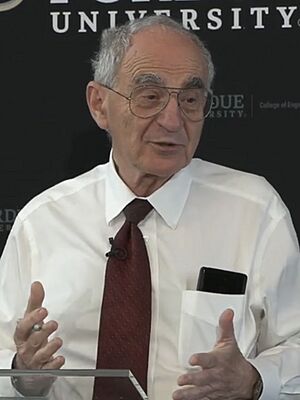Eli Yablonovitch facts for kids
Quick facts for kids
Eli Yablonovitch
|
|
|---|---|

Yablonovitch in 2024
|
|
| Born | 15 December 1946 Puch bei Hallein, Austria
|
| Alma mater | |
| Known for |
|
| Awards |
|
| Scientific career | |
| Fields | Physics, Electrical Engineering |
| Institutions | |
| Doctoral advisor | Nicolaas Bloembergen |
Eli Yablonovitch, born on December 15, 1946, is a famous American scientist. He is both a physicist and an engineer. He is known for starting the field of photonic crystals in 1987 with Sajeev John. Photonic crystals are special materials that can control light.
Dr. Yablonovitch and his team were the first to build a 3D structure called Yablonovite. This structure could stop light from passing through it in certain ways. He also discovered a new type of semiconductor laser that uses less power. These lasers are now used in many devices around the world. His work on how light behaves in photonic crystals is very important in science.
Contents
Eli Yablonovitch's Education and Early Work
Eli Yablonovitch studied physics at McGill University. He earned his first degree there in 1967. He then went to Harvard University to study applied physics. He received his master's degree in 1969 and his Ph.D. in 1972. During his studies, he worked with special carbon dioxide lasers. He explored how light interacts with materials in new ways.
Working at Bell Labs and Harvard
After finishing his Ph.D., Dr. Yablonovitch worked at Bell Laboratories. This was a famous research center. In 1974, he became a professor at Harvard University. He taught applied physics there.
Researching Solar Energy
In 1979, he joined the Exxon research center. Here, he focused on photovoltaics, which is about turning sunlight into electricity. While at Exxon, he figured out a key rule for solar cells. This rule helps solar panels capture the most light possible. It is now used in almost all solar panels worldwide.
Pioneering Photonic Crystals
Dr. Yablonovitch moved to Bell Communications Research in 1984. By 1991, he was leading their solid-state physics research. It was during this time that he did his groundbreaking work on photonic crystals. This research changed how scientists think about controlling light.
Later Work at UCLA and UC Berkeley
Later, Dr. Yablonovitch became a professor at UCLA. He continued to develop photonic crystals and related materials. In 2007, he joined the Electrical Engineering and Computer Sciences department at UC Berkeley. His research there includes silicon photonics, which uses light in computer chips. He also works on telecommunications and new ways to use solar energy. He is also looking for new ways to make computer parts that use less power.
Eli Yablonovitch's Companies
Dr. Yablonovitch has helped start several companies. These companies use his research to create new products.
Ethertronics Inc.
In 2000, he co-founded Ethertronics Inc. This company makes antennas for cell phones. They have shipped over 1.7 billion antennas so far.
Luxtera Inc.
In 2001, he also co-founded Luxtera Inc.. This company creates special electronic and optical systems. They use a method called silicon photonics to make these systems. Luxtera was the first company to use this method widely.
Luminescent Inc.
He co-founded Luminescent Inc. in 2002. This company developed advanced ways to make computer chips. Luminescent was bought by another company, Synopsys, in 2012.
Alta Devices Inc.
In 2008, Dr. Yablonovitch started Alta Devices Inc. This company makes very thin solar cells. These cells are made from a material called gallium arsenide. Alta Devices holds world records for how efficiently their solar cells turn sunlight into electricity.
Awards and Honors
Eli Yablonovitch has received many important awards for his scientific work. He is a Fellow of several major scientific groups. These include the Institute of Electrical and Electronics Engineers (IEEE) and the Optical Society of America (OSA). He is also a Fellow of the American Physical Society (APS).
He has been chosen as a member of many important academies. These include the National Academy of Sciences and the National Academy of Engineering. He is also a Foreign Member of the Royal Society of London.
Some of his notable awards include:
- 1978 Adolph Lomb Medal
- 1996 R. W. Wood Prize
- 2010 Mountbatten Medal
- 2011 Clarivate Citation laureate in Physics (shared with Sajeev John)
- 2012 IEEE Photonics Award
- 2012 Harvey Prize
- 2014 Rank Prize for Optoelectronics
- 2015 Isaac Newton Medal
- 2016 Oliver E. Buckley Condensed Matter Prize
- 2017 IEEE William R. Cherry Award (the highest IEEE award for solar cells)
- 2018 IEEE Edison Medal
- 2019 Frederic Ives Medal / Jarus W. Quinn Prize (the highest award from the Optical Society)
- 2019 Benjamin Franklin Medal
See also
- Alf Adams. He also worked on similar laser ideas around the same time as Yablonovitch.

